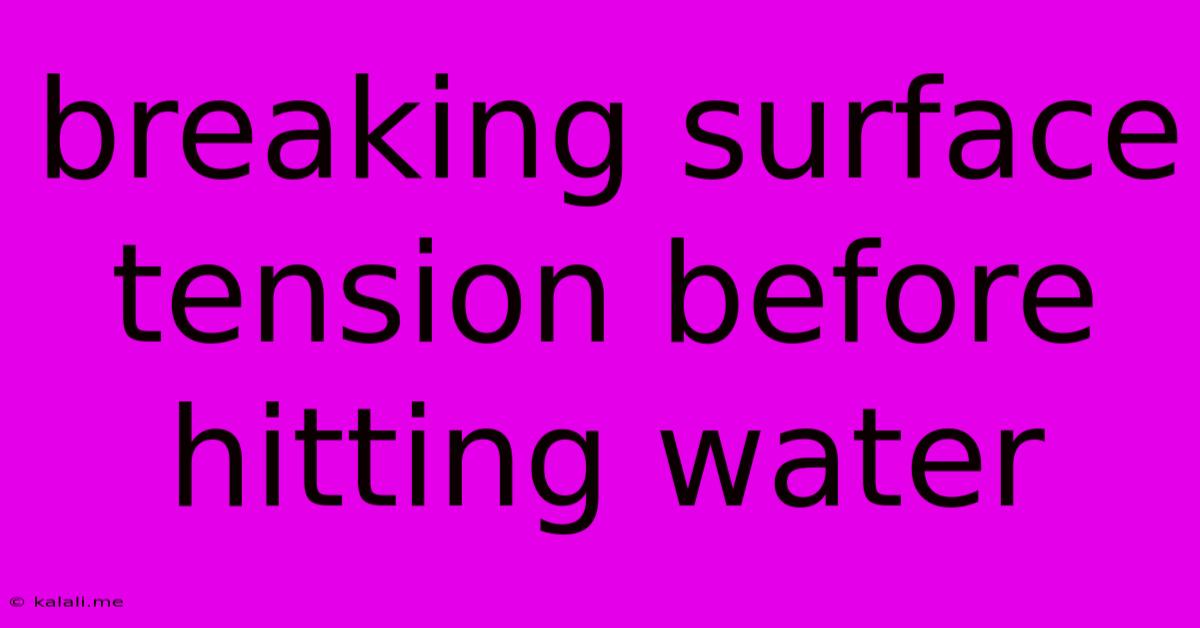Breaking Surface Tension Before Hitting Water
Kalali
Jun 08, 2025 · 3 min read

Table of Contents
Breaking Surface Tension Before Hitting Water: A Deep Dive into Entry Techniques
Meta Description: Learn how to minimize the impact of water's surface tension when diving, jumping, or entering water. This guide explores techniques for a smoother, less jarring entry, covering everything from optimal body positioning to specialized equipment.
Water's surface tension, that invisible "skin" on the surface, can be a significant force to overcome when entering the water. A poorly executed entry can lead to painful splashes, stinging eyes, and even injuries. Understanding and minimizing the effects of surface tension is crucial for divers, swimmers, and anyone who frequently enters water. This article explores various techniques and considerations for breaking surface tension before impact.
Understanding Surface Tension
Before diving into techniques, let's briefly understand the physics. Surface tension arises from the cohesive forces between water molecules. These molecules are more strongly attracted to each other than to the air above, creating a sort of elastic membrane. The stronger the surface tension, the greater the resistance you'll experience upon entry.
Factors influencing surface tension include water temperature (colder water has higher tension) and the presence of contaminants (like detergents or oils).
Techniques for Minimizing Impact
Several methods can help minimize the impact of surface tension:
1. Entry Angle and Body Position:
- Streamlined Entry: The most effective way to break surface tension is by entering the water at a shallow angle, minimizing the surface area contacting the water at once. Think of a knife cutting through butter – a sharp edge minimizes resistance. A streamlined, spear-like entry is ideal.
- Proper Body Alignment: Maintaining a straight, vertical alignment helps distribute the force of impact across your body, reducing stress on any single point. Avoid entering the water with bent limbs or a twisted torso.
2. Entry Speed and Momentum:
- Sufficient Velocity: Sufficient speed helps pierce the surface tension rather than simply impacting it. However, excessive speed can be dangerous. Find a balance between momentum and control.
- Controlled Entry: While speed is important, controlled entry is paramount. A haphazard, uncontrolled entry will increase the impact. Practice controlled dives and jumps before attempting high-speed entries.
3. Specialized Techniques:
- Diving Techniques: Experienced divers often utilize specific techniques like the "tuck" position to minimize resistance and maximize penetration. This involves tucking your knees towards your chest to create a more compact and streamlined profile.
- Water Entry Training: Professional divers and athletes often receive training specifically focused on optimized water entry techniques to mitigate the impacts.
4. Equipment and Materials:
- Wetsuits and Swimsuits: While not directly breaking surface tension, these materials can help reduce friction and the sensation of impact upon entry. Their hydrodynamic properties aid in a smoother entry.
Beyond Technique: Practical Considerations
- Water Temperature: Colder water has higher surface tension, so be mindful of the water temperature and adjust your approach accordingly.
- Water Conditions: The presence of waves, currents, and other water conditions can affect your entry. Always assess the situation before you jump or dive.
- Practice Makes Perfect: Regular practice is key to mastering techniques for minimizing the impact of surface tension. Start with low-impact entries and gradually increase the difficulty as you improve your skills and confidence.
By understanding the physics of surface tension and employing the techniques outlined above, you can significantly reduce the jarring impact of entering water, improving your comfort and safety in various aquatic activities. Remember that a controlled, streamlined entry is crucial for minimizing resistance and maximizing a smooth, efficient penetration of the water's surface.
Latest Posts
Latest Posts
-
How Soon Can You Paint Treated Wood
Jun 08, 2025
-
How Do I Determine If My Car Battery Needs Replacing
Jun 08, 2025
-
Is It Safe To Eat Cooked Chicken With Blood
Jun 08, 2025
-
Interaction For Complete Your Profile In App Ui
Jun 08, 2025
-
Mentioned A Third Party Site On Steam
Jun 08, 2025
Related Post
Thank you for visiting our website which covers about Breaking Surface Tension Before Hitting Water . We hope the information provided has been useful to you. Feel free to contact us if you have any questions or need further assistance. See you next time and don't miss to bookmark.